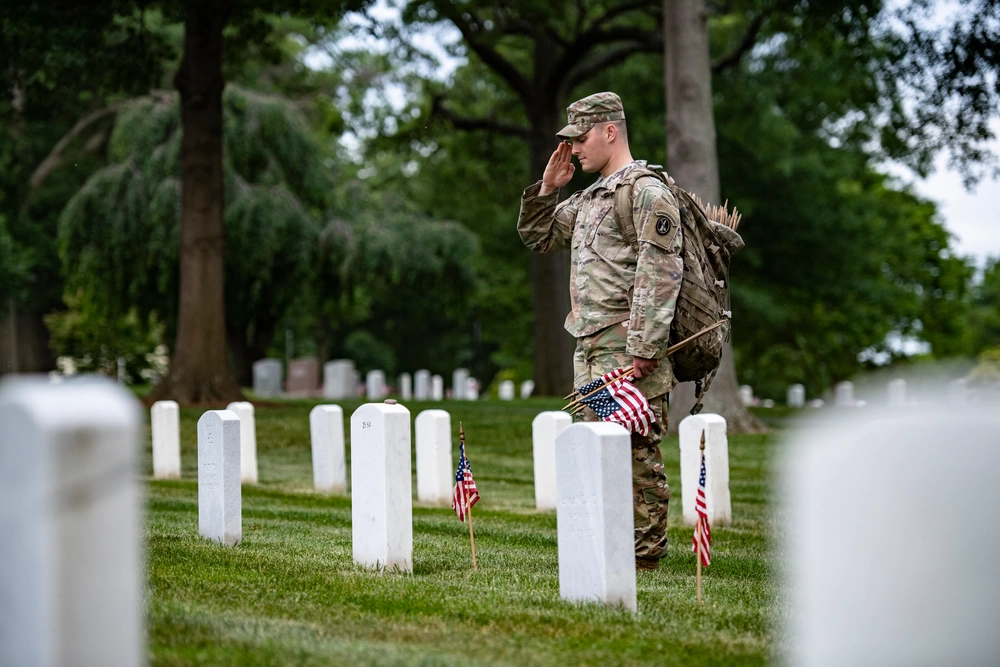
U.S. Army photo by Elizabeth Fraser / Arlington National Cemetery
by Robin Beres
Virginia is brimming with famous and consequential landmarks and tourist sites. From the Historic Triangle to St. John’s Church in Richmond, to great beaches, mountains, and countless old plantation homes, vineyards, and breweries, there is a lot to see and do in the commonwealth. It’s little wonder that Virginia is ranked No. 6 in most visited states in the U.S. according to the World Atlas.
While there is much to see in Virginia that is upbeat and fun, there are also solemn and sobering experiences to take in as well. Some of the bloodiest battles of the Civil War took place in Spotsylvania Court House, the Wilderness, and Chancellorsville. Both Revolutionary War and Civil War victories happened in our beloved state.
It is important that we all take time to appreciate the sacrifices so many Americans serving in uniform have made to ensure our freedoms. That is the very reason we have this Memorial Day weekend.
While by no means a tourist site, Arlington National Cemetery (ANC) is one of the most visited places in Virginia. Located just across the Potomac River from Washington, D.C. The national cemetery is built on the grounds of a plantation that once belonged to Mary Anna Custis Lee, wife of Confederate General Robert E. Lee. The family vacated the home shortly after the Civil War began.
As the war dragged on, casualties continued to mount. By the spring of 1864, nearly every inch of ground in churchyards, hospitals, and even private homes around Washington had been turned into burial plots. With body counts still growing and desperate for more land, Gen. Montgomery C. Meigs, quartermaster-general of the U.S. Army, was a staunch Unionist. He decided that burying fallen troops at Arlington, Lee’s beloved home, would be the ultimate retribution to what he considered Lee’s act of treason. It took little persuasion to convince others of his plan. On June 15, 1864, U.S. Secretary of War Edwin M. Stanton issued an order that turned the grand estate into a graveyard.
By the time the war ended less than a year later, more than 5,000 soldiers were interred on Arlington’s rolling green fields. The resting spot soon became known as the preferred final resting place for the gallant dead. It became commonplace for senior officers and leaders to request to be buried with their men at Arlington.
The original 200 acres of the cemetery have grown to 639 today. The hallowed grounds serve as the final resting place for more than 400,000 military members from all branches of the armed forces. There are two U.S. presidents, 14 Supreme Court justices, and more than 400 Medal of Honor recipients from the Civil War to the Global War on Terror. Notables such as Gen. John “Black Jack” Pershing and Maj. Audie Murphy are buried here.
The most famous — and most solemn site — is the Tomb of the Unknown Soldier. The Tomb contains the remains of soldiers from World War I, World War II and Korea, and until 25 years ago, the remains of a Vietnam-era unknown. In 1998, Air Force Lt. Michael Blassie’s remains were exhumed and identified through DNA testing.
Since 1948, the Tomb of the Unknown Soldier has been guarded by soldiers from the 3rd Infantry, traditionally known as The Old Guard. The soldiers maintain a 24-hour vigil, 365 days a year. The military guard at the tomb is changed in an elaborate ceremony which happens every half hour from April 1 through September 30.
In honor of this Memorial Day, at sunrise on Thursday, May 25, during a ceremony known as “Flags In,” more than 1,000 active-duty troops showed up at ANC to place American flags on 260,000 headstones.
On Sunday, May 28, Arlington officials have announced that there will be a Flowers of Remembrance Day to be held at the Tomb of the Unknown Soldier. The ceremony will pay homage to the first national Decoration Day (which eventually became today’s holiday, Memorial Day).
According to the cemetery’s website:
At 10 a.m. in the outdoor bowl of Memorial Amphitheater, ANC historians will offer a public program on the history of Decoration Day/Memorial Day, this holiday’s importance to ANC and its connections to the Flowers of Remembrance Day event. After the 10 a.m. talk, they will lead an optional, supplemental walking tour to the James Tanner Amphitheater, the Tomb of the Civil War Unknowns and other locations related to the official Decoration Day commemoration at ANC. No registration is necessary for participation.
“Every day is Memorial Day at Arlington National Cemetery,” said Superintendent of Arlington National Cemetery Charles “Ray” Alexander, Jr. “This day will provide the American public the special opportunity to see this iconic memorial up close and to reflect on the service, valor and sacrifice it represents.”
If you can’t make the trek up Interstate 95 this weekend, plan to do so soon. And take a moment this Memorial Day to reflect on those rows of white marble tombstones — not only at Arlington but at cemeteries across the nation and American cemeteries across the globe.


